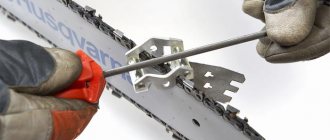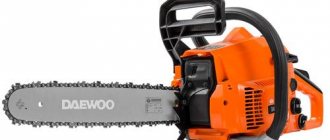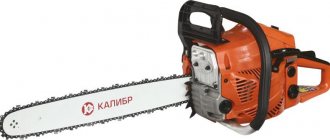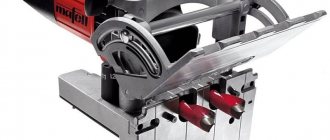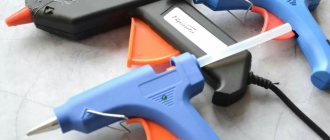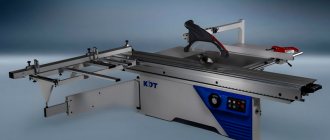In a private house there is always a lot of work with wood: preparing firewood, removing excess branches on garden plants, cutting boards for a fence, etc. To make these tasks easier and faster, chainsaws are used. They are also actively used in the construction of bathhouses and log houses. With the help of professional models, the forest is cut down. This article will help you understand the differences between the tools and teach you how to choose them correctly.
The best chainsaw manufacturers - which company to choose
To purchase a high-quality chain tool for cutting wood, you can turn to the products of the best chainsaw manufacturers:
1.Huter
2. Makita
3.ECHO
4. Husqvarna
5. Stihl
After reading a detailed overview of the models, you will be able to see the suitability of garden tools for various needs. Those who want to delve into all the features of chainsaws and choose each parameter personally should read this article to the end.
Recommendations: 12 Best Pruning Saws
15 best chainsaws
16 Best Electric Chainsaws
The principle of operation and design of a chainsaw
Chainsaws are used in a wide variety of conditions: from small work in the garden (trimming branches, twigs, removing unnecessary wood), to construction and professional logging. The small tool is completely autonomous, as it runs on fuel. It can be taken far from civilization and work all day long, if you have an additional canister. The unpretentious device rarely breaks and is easy to repair.
The operating principle of the tool is to operate an internal combustion engine, for which there is a small fuel tank and an oil reservoir. The rotation of the power unit transmits torque to the sprocket, which includes the legs of the chain. The movement of the links is started along a tire consisting of two connected strips. There is a groove on its edge, thanks to which the legs sit deeply and the chain does not fly off.
Sawing is carried out by rotating the chain at high speed, which reaches 9000 rpm. The link structure has protruding tenons that engage the wood fiber and cut it. The operator holds the device suspended by two handles. One has keys for starting rotation, as well as a lock against accidental activation. The engine starts from a cable starting mechanism.
Depending on the engine size, the tool can be used from 2 to 16 hours. Most models are equipped with an emergency chain brake system that is activated if an urgent stop of rotation is required. The tension of the cutting element is carried out by the movement of the bar in the grooves and its fixation with bolts or a clamping screw. The latter allows you to adjust the chain within a minute and immediately continue working.
The chainsaw includes the following elements:
- motor;
- fuel tank;
- two handles;
- guide bar;
- saw chain;
- protection shield;
- starting device;
- gear stop.
Possible problems
The most common problems with gasoline devices:
- Do not start the engine. You should check the gasoline level. If there is enough gasoline, you need to clean the fuel filters and a special sump, and blow out the gasoline hose. Check the condition of the spark plug and clean it from carbon deposits. On modern engines, it is impossible to check for the presence of a spark by shorting the high-voltage wire to the housing.
- Business interruptions. It is possible that water may get into the fuel. In this case, you should replace the fuel with high-quality fuel. It is also possible that the cylinder jacket to the crankcase is loosened; the nuts should be tightened more tightly.
- Motor overheating. Clean the slots in the air radiator jacket. Check the percentage of oil in the fuel using the table in the owner's manual.
You should not try to fix the remaining faults yourself if you are not sure that you have sufficient skills, but contact a service center. Unqualified self-repair can completely disable the unit, and no warranty will be valid in this case.
Types of chainsaws
Household chainsaws
The units are distinguished by a small engine capacity of up to 40 cm3, short tires (25-35 cm) and low power. They are used in dachas for cutting firewood, cutting down unnecessary trees, and minor construction work.
Advantages:
- compact size, convenient for transportation;
- economical fuel consumption;
- relatively quiet operation;
- cheap price.
Flaws:
- the tool can be worked without stopping for only one to two hours;
- To cut down a thick apple tree, you will need to make a pass from several sides;
- in some models, the chain is tensioned only with a key;
- On hard material the device wears out quickly.
Semi-professional
Devices with an engine capacity of 40-60 cm3. allow you to use them throughout the day with short breaks. They are often equipped with longer tires of 40-45 cm. The power of the chainsaw reaches 2-3 kW, which allows them to be used in the construction of bathhouses, houses or yard structures. They are convenient for cutting out an opening for a window or door.
Advantages:
- you can work 6-8 hours;
- wide range of prices (depending on the manufacturer);
- wide application;
- the presence of an emergency brake;
- quick chain adjustment.
Flaws:
- some models interact only with original components;
- The width of the groove does not always correspond to the power of the device, and the tire may bend when biting.
Professional
A tool with high power up to 6 kW, long tires up to 60 cm and a power unit volume of 60-120 cm3. In active mode they work for up to 8 hours, and with short breaks they can function for 16 hours a day. This is ideal for felling trees.
Advantages:
- high power;
- long work;
- emergency brake;
- cutting through even thick trunks in one go;
- wear-resistant components.
Flaws:
- high price;
- Your hands get tired quickly from the weight and vibration.
Classification
Based on the design features, purpose, functionality and resource provided by the manufacturer, the following classification of chainsaws has been adopted:
- Household.
- Semi-professional.
- Professional.
- One-handed.
The first ones are designed for periodic performance of short-term and small-scale work that meets the needs of a resident of a country house. If you need to choose an inexpensive chainsaw for your dacha that will allow you to perform everyday tasks, be it harvesting, pruning or cutting down small trees on your property, then pay attention to household models.
A semi-professional tool is designed to perform the same work as a household one, with the only difference being the increased performance associated with the duration and volume of work performed.
A professional gasoline tool can be easily used both for pruning branches in the garden and for professional harvesting of “centuries-old” trees. The other side of the coin of such devices is the high price and weight and size indicators.
Important! Without professional skills, it will be very difficult to cope with such a unit. A characteristic feature of professional equipment is a high level of vibration and significant weight.
One-handed saws allow the owner to work with one hand. Structurally, one-handed saws are practically no different from household, semi-professional or professional models, with the only difference being the location of the handle, which is installed not behind the device, but on top, directly above the center of gravity. One-handed saws have two undeniable advantages:
- compactness;
- ease of use.
The only drawback of such a tool is its relatively high cost.
Household chainsaw
Semi-professional chainsaw
Professional chainsaw
One-handed chainsaw
Chainsaw selection options
Understanding the relationship between each characteristic of a chain tool will help you select the device that is suitable for the required application. Here are the main parameters and their purpose.
Tire length
This characteristic has a range from 30 to 60 cm, which affects the ability of the tool to cut a certain diameter of the trunk at a time:
1. Models with a parameter of 35-38 cm are suitable for preparing firewood, cutting knots and minor work in the yard. You can cut down a tree with this device, but you may have to make two cuts to cut through the entire trunk.
2. Chainsaws with a 40-45 cm tire are suitable for working with soft and harder trees and small construction (sauna, gazebo, veranda). They are also used to form the roof (trimming rafters, awnings).
3. A tool with a 50-60 cm tire is used in professional felling, where cutting through thick trunks is required.
By installing a long tire on a low-power device, the user dooms it to rapid wear and tear. Short buses on professional devices work equally well as long ones.
Power
This setting affects performance. It is measured in hp. motor or converted into the electrical value kW, where 1 hp. equal to 0.75 kW:
1. A tool with a rating of up to 2 kW is suitable for country use.
2. Models 2-3 kW are designed for cutting soft and medium-hard species (pine, poplar, maple, birch) and will be useful both in the country and in short construction projects.
3. From 4 to 6.5 kW, professional equipment designed for felling has indicators.
If the machine's power does not match the work being performed, the operator will have to apply more pressure to the tire, and the rotating mechanisms may jam when in contact with hard materials.
Engine capacity
There are models from 25 to 120 cm3. with the total volume of all cylinders. This parameter affects how long the tool operates during the day:
1. Chainsaws with motors up to 40 cm3. suitable for working for a couple of hours, after which they require a long break. Therefore, they are suitable for seasonal, everyday firewood collection, gardening, and fence construction.
2. Units up to 60 cm cubic. can function up to 8 hours a day, which makes them suitable for semi-professional work at a small construction site, construction of a gazebo, canopy.
3. Devices with a volume from 60 to 120 cm3. allow you to work continuously for 8 hours or with breaks up to 16 hours a day. The tool can be used to cut wood even in two shifts.
Groove width
This characteristic is important when calculating the hardness of the material being cut. If you have to constantly work with soft tree species, then 1.1-1.3 mm is sufficient. Accordingly, the chain leg that fits into the groove will be thinner, but the saw will be able to work properly for a long time. But when you start systematically cutting oak, beech, and ash with such a tool, the chain will quickly wear out and break.
A groove of 1.5-1.6 mm means a thicker chain, which is useful when working regularly with hardwoods. But this will not affect soft materials in any way, so here it is not worth overpaying for a wider groove.
Chain pitch
A chain with a certain pitch moves along the bus. It is the distance between three links divided by two. The speed of cutting the material depends on it.
There are three known meanings:
- 0.325 inch is used for cutting knots and small garden work;
- 0.375 inches is suitable for small construction;
- 0.404 inches will be needed in a full-time job where time and deadlines are of the essence.
But in proportion to the increase in speed, the vibration on the tool handles will also increase, so a model with a long chain pitch is suitable for use only by professionals who know how to handle such equipment well.
Chainsaw weight
Cutting units can weigh from 2.7 to 8 kg:
1. For work at height (trimming branches on trees), lightweight models up to 3.5 kg are useful.
2. It is convenient to prepare a log house for a bathhouse or cut out openings for doors and windows with a tool weighing 4-5 kg.
3. Powerful, heavy machines are designed for sawing low above the ground (thick trunks), but require experience and physical endurance. People with limited loads will find it difficult to manage them.
Emergency brake
When the end of the bar hits the material being cut, the entire tool receives a backlash and is thrown back towards the operator. If the chain continues to rotate at this moment, it may accidentally cut clothing or cause injury to a person.
Some models are equipped with an emergency brake, which interacts with the tool's protective frame. During a reverse impact, a person mechanically hits the limiter with his hand, which leads to the chain brake. The system stops when the cutting element jams in order to protect the internal parts from destruction. This function is useful for beginners or those who constantly saw vertical logs and trunks, where there is a high probability of the chain being “bitten” by the mass of the material being cut.
Fuel tank
Its volume affects the ability to work without stopping. This is especially important for workers involved in construction or logging. Here you can purchase a tool with a maximum capacity of 0.55 liters. For a summer house or periodic work (building your own gazebo, bathhouse), where time is tight, you can buy a chainsaw with a 0.3 liter tank.
What else should you pay attention to?
If you are really puzzled by the question of choosing an inexpensive brand of chainsaw , then you should pay attention to:
- on the location of the engine;
- cutting speed;
- availability of vibration protection.
Powerplant position
Structurally, the engine in such units can be located vertically or horizontally. When the power plant is placed vertically, the manufacturer has the opportunity to equip the tool with a fairly serious muffler, which will significantly reduce the noise that inevitably appears during the operation of the device. This layout of the power plant is most often used in professional equipment.
The horizontal arrangement of the engine allows us to make a tool with the most compact weight and size characteristics. This design has become popular among owners of dachas and country houses.
Cutting speed
The speed of cutting directly depends on the speed of rotation of the chain, the design of the headset and the configuration of the saw tooth. In a modern tool, almost all of the above indicators are identical, the only difference being the material from which the saw chain teeth are made. The grade of steel will tell an experienced operator the frequency with which he will have to sharpen the chain after continuous use of the tool.
Vibration protection
Anti-vibration protection is a pad made of soft material located at the point where the handle is attached to the device body. In expensive units, instead of a gasket, a system of springs is used that effectively dampens vibration. As a rule, such protection is implemented only in semi-professional and professional equipment. In household budget saws, anti-vibration protection is not provided.
Which chainsaw to choose
Having learned the key selection criteria, we can highlight several specific recommendations for a specific type of work:
1. A chainsaw for the dacha for cutting branches in the garden, preparing firewood, small work, will require a 30-35 cm tire, a power of 1.5 kW, a power unit volume of 40 cm cubic, a groove width of 1.1 mm, with a cutting pitch element 0.325 inches. It will be convenient to handle weights up to 3 kg.
2. To cut only soft wood (pine, poplar, linden, alder), you will need a tool with a 40 cm bar, a power of 2 kW, a chain pitch of 0.325 inches, a groove width of 1.3 mm and a weight of 3-4 kg.
3. For active use at the construction site of bathhouses, houses, gazebos, you need a chainsaw with a 50 cm tire, a tank volume of 0.3 l, a motor with cylinders up to 40 cm3, a power of 4 kW and a chain pitch of 0.375 inches, a weight of 5 kg and the width of the slot for the leg is 1.5 mm.
4. For professional felling, units with a 60 cm tire, a power of 6 kW, an engine capacity of 100-120 cm3, and a groove width of 1.6 mm are used. The chain pitch should be 0.404 inches and the weight should be between 6-8 kg. Kickback protection and a 0.55 liter tank are required.
The biggest
Carver RSG 262
pros
- high-quality assembly
- affordable price
- quick start system
- low noise and vibration levels
Minuses
- heavy weight (7.5 kg)
From 6493 ₽
A powerful hand chainsaw with a bar length of 70 cm. This is a semi-professional tool that is used for sawing wood, preparing fuel, and pruning trees. The model is equipped with an economical 2300 W motor. Thanks to the presence of electronic ignition and semi-automatic control of the carburetor damper, the saw starts easily at low temperatures.

